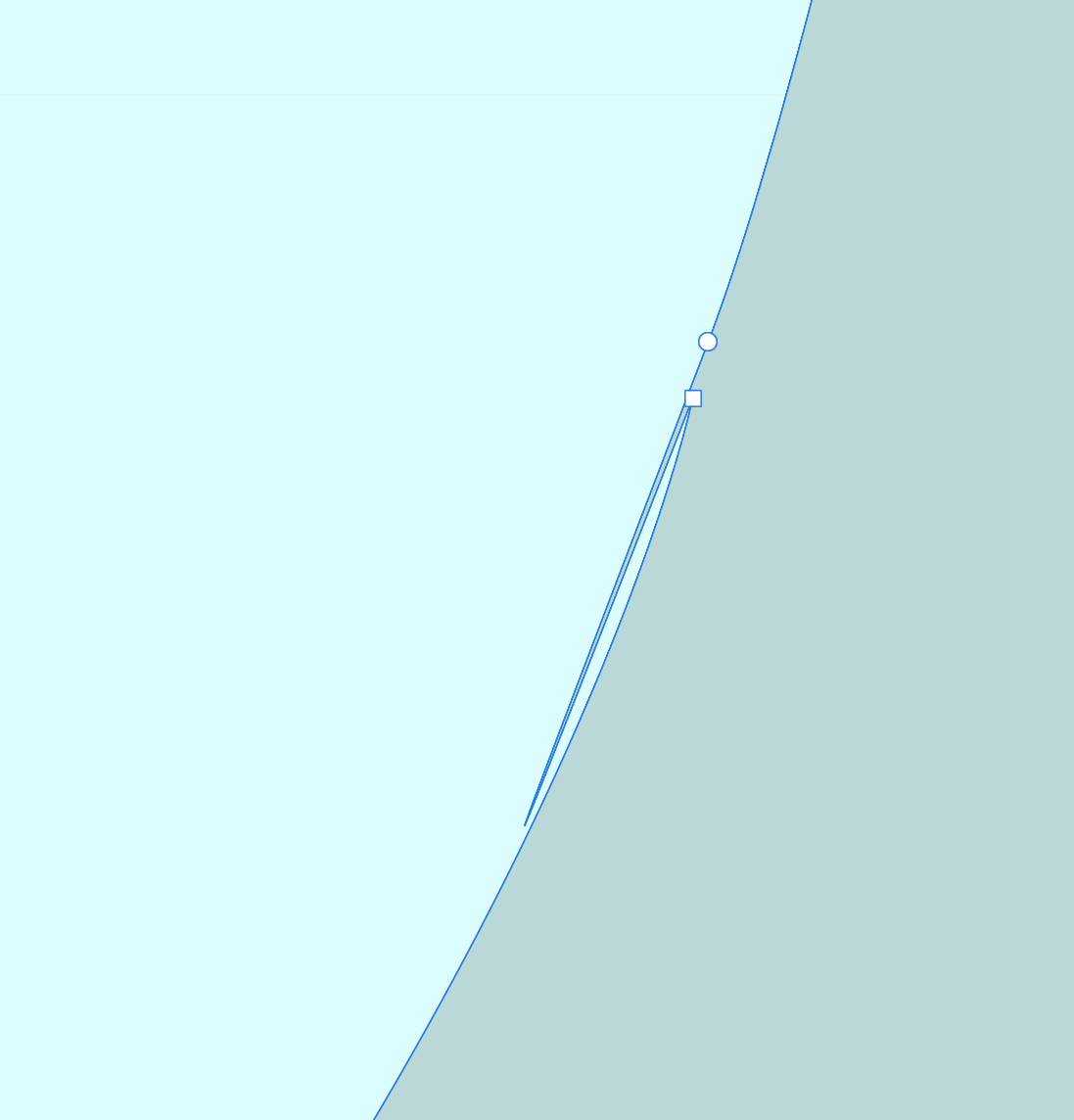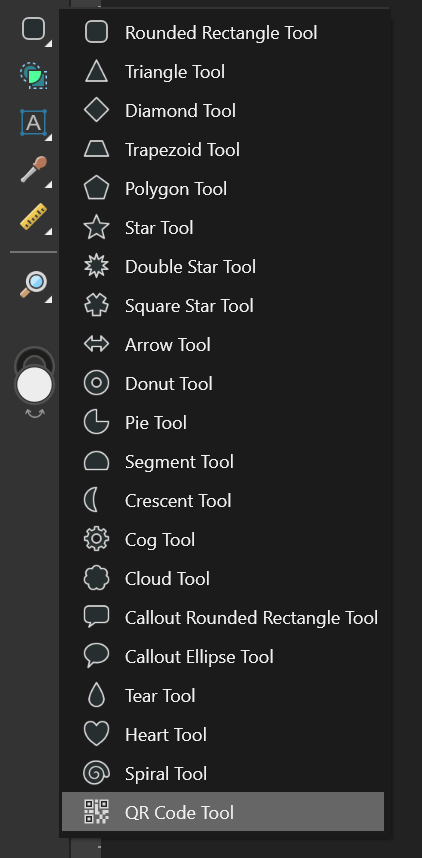-
Posts
372 -
Joined
-
Last visited
Posts posted by Paul Mc
-
-
I can create a QR barcode using the QR code tool in Affinity Designer however it is stuck on the default value (the Affinity web address). Clicking on the Data button does not reveal the dialog box that I have previously seen so I'm unable to change the value.
Further testing shows this works as expected in Affinity Photo and I'm able to create and copy that across to my Designer document. One strange thing that might not be related is that when I click on the Data button I see a small crosshair appear at the top left of the document canvas.
Version 2.5.3 on Windows 10.
-
Are there any plans to provide access to the error correction level value when creating QR codes? I've been asked a couple of times by clients wanting to drop their logo or a symbol in the centre but the current error correction level makes the barcode unreliable/unreadable.
-
There are a few weird curve nodes in your outlines that I suspect are causing the artefacts.
e.g. for the large white "spike" on the 'S' of Sheriff - if you zoom into the curve near the base you will see this:

Deleting the square (Sharp) node changes the curve very slightly but also removes the artefact. It might be worth zooming into the other locations to see if there are any unusual node positions and or types that are not perceptible at normal viewing scale.
Update:
Checking the other artefacts that I spotted show that they all have two sharp nodes very close together where the issues are visible after export. (Also note that the problem is due to the curves being flattened - the same effect as Expand Stroke in the Layer menu). In all the cases I saw, removing one of the nodes fixed the issue. Of course, this may alter the curve a little but my eyes could tell the difference in most cases.
-
These types of QR codes rely on a high error correction level. This then allows you to effectively "destroy" or obliterate part of the barcode and it will still scan because there is redundant data elsewhere in the barcode that allows the whole data value to be reconstructed.
The error correction section here has more info https://en.wikipedia.org/wiki/QR_code
As far as I can see there is nowhere that you can set the error correction level in Affinity programs. Eyeballing the codes I would expect it to be (L)ow. Maybe something for a future enhancement?
-
I think that is right from my playing earlier. Maybe there is no way to send the DPI info via the clipboard so it defaults to 96. For some reason I broke with my normal workflow which would be to save a copy and delete extraneous content, that way the document, dimensions, colour space, margins, guides etc. are retained plus of course, the DPI. Lesson learned!
- walt.farrell and Oufti
-
 2
2
-
Spot on @walt.farrell - the original was 300dpi the new one 96 dpi. I can't for the life of me see any logic there. This is Designer and the content is vector where DPI is academic for most work. I could see that perhaps pasting a copy into another document with a different DPI might require a resize but not when creating a new document.
The printer thinks I'm losing it! 🤣
Thanks Walt.
-
It is weird that this has just started happening - twice in one day. It seems that the clipboard is not retaining the original dimensions. I have a large design and the printer has just asked for an element to be broken out so that it can be made as sticker as positioning on the final background may need to change. I copy the outline element which is ~1400mm wide and then using Create new from clipboard I see that the dimensions are over 5000mm. The exported PDF gives the above error as you might expect. The background graphic (which houses a hidden group with the outline element) exports fine and at the correct scale. Any idea why this is happening and what I can do to prevent it in future? Is it something to do with Scale with object?
-
I wonder if a customisation in a previous version, via View > Customize Tools... as @R C-R mentioned, means that this is not visible by default as it wasn't included in the custom set of tools shown when the update goes through.
-
Hi Tony, it is at the end of the shape tools on my install:

As far as I know this is bundled with 2.5 and there is no way to enable or disable it so it should be visible.
Maybe try a shortcut to see if that triggers it like I've done with 'Q' here:

-
I had a job a little while ago which use a proprietary font and the client (who owned the rights) could no longer find the font file to share with me so that I could update the designs. It is pretty frustrating when Adobe Reader displays it and the customer doesn't really understand why you can access it. In this case I ended up using FontForge to extract the font file from the PDF and then I could install it and use it to develop the design. This time the complete font was present. Usually you only see the used subset of the font and it isn't much use unless you are only wanting a few characters. I know there are a couple of other programs out there that do a similar job. Good luck.
-
It depends on the result you are aiming for. For a quick scale-to-fit-the-page-print I normally select everything, Copy and then use New from Clipboard and then print that using the Scale to fit option in my print dialog. For real scale I use Actual size (I think - I'm not at my workstation atm) in the print dialog. The thing that can defeat this method is when you have a rotated object and the bounding box is also rotated so corners extend the selection beyond the visible content edges. In that case you need to fix the bounding box issue by using full stop and then Ctrl+full stop IIRC. This is all from memory so apologies if it is not complete are completely accurate.
-
Hey, @firstdefence, thanks for going to all this trouble. That's interesting what you have found. I think in my case the gradients are part of the final output file as there is a distinct colour change between the original and the AD import. I appreciate the effort that you have gone to but I don't think this is worth taking any further on my behalf though.
Cheers.
-
Thanks @firstdefence I did search but saw nothing quite like this. I guessed that it would be something that Affinity hasn't catered for in its processing of PSDs. I'm not confident about receiving a more compatible file so I'm exploring ways forward. I'm thinking that as the process is going to print (and the source is RGB) that I can hide/explain some of the colour shifts down to the CMYK conversion but I might have to eyeball some tweaks so that it's still "within acceptable parameters"! 😊
-
Hi everyone
Before you tell me what this means - I know!
I'm working downstream of an agency who care little about me or Affinity Product compatibility. The "source files" they sent on which to base my work were all IDMLs with linked PSDs. I need to incorporate them into a new design and some of the colours are way off - I presume because of the errors thrown up when the import is done. Does anyone know what in PS these relate to? I'm hoping that someone can flatten or bake the effects in a manner that will not cause a problem by the time it reaches me. i.e. I need to write a request in detail but I've no idea what the correct terminology should be. I asked for a PDF but I ended up with a file that was rasterised down to a handful of layers - so I think I need to spell out things in more detail. (It is a long time since I used PS).

-
I know this isn't an Affinity only issue but I was wondering how you all manage multiple screens. I've a display tablet and when I switch to that for any AP or AD work I launch on the main screen and then drag to the other display as normal. As soon as a popup dialog appears then that will be visible on the last screen it was shown on - not necessarily the one I'm focussed on. I'm on Windows and I was wondering if anyone has found any settings or apps that will have any dialogs follow the main application screen. TIA.
-
Hi @DWright please would you expand on your answer. The chap I'm dealing with at the printer was puzzled but this. I tried exporting using the three "/x" variants in AP but nothing came back with the white layer separated out. Online info on this aspect of the PDF format seemed pretty minimal. Due to time pressure the job is now done. I manually created the white layers. I would still be interested in how it could be done for future projects using this method as I had three change requests on the "final" artwork of this one and they were a fiddle to apply as the content and white layer had to be kept in sync. Thanks.
-
I had a problem recently where the progress bar locked up at a similar position. However the file was written successfully in spite of the gauge not reaching 100% (I can't remember what the position was, sorry). Switching windows to another app and then back again to AP allowed me to close the progress bar window and resume work. This happened several times. Is AP locking up when you see the progress bar stop? Maybe check if the output file has been created?
-
-
Thanks so much, @lacerto you are a lifesaver. This was driving me crackers. I had completely forgotten about passthrough/interpret! I now have everything working correctly. You went to a lot of trouble to reproduce the effect and I appreciate the effort. Thank you.
I no longer have an Adobe subscription so wasn't able to check the output preview but I'm reassured by your video that everything will work OK. The deadline was Friday but the printer has been gracious enough to stretch things until Monday if I could fix this. BTW, there was also an issue with 100%k blacks on text going the same way and this fixed that issue too.
Thanks again and have a great weekend.
-
I'm working on a project where I create designs in Designer and then use a merge in Publisher to pull them all together into a multipage document. In the main this is working fine. This is a print project and all the elements are in CMYK using the same colour profile. Creating an element in Designer directly (I think) I get the correct colour, and the same for Publisher. However if I load a Designer created PDF image into a Publisher Picture Frame I get a slight colour shift. The same object inserted into the document directly as a curve works fine. Here's a sample of the colour effect that I'm seeing:

All these "pinks" should be the same colour. The darker one is the correct I think.
The original colour in AD is (3,95,51,10). Once it appears in the merged AP output file the upper left one is (4,91,44,9) and the lower right (4,91,45,9). I'm saving all the assets in PDF format with the colour profile of the document. Originally I used SVG files and found that these can't use CMYK colours (yet) so switched to PDFs in the hope that these would work. Static elements in the Master Page of the AP document created using this colour are fine and have the same colour in the output. It is the Picture Frames that have the issue.
Can I assume that this is not due to this problem from a while ago?
I've tried it with and without the option to embed ICC profiles with no change as well as experimenting with several other changes.
I am completely lost as to why this is happening.
I can't share files here as it is client work. The colour profile is PSO Coated v3 in case that is relevant. It wasn't installed by default and I had to download and install it for this project.
I'm on Windows using version 2.4.2 in all programs.
Please can you suggest anything I can try to identify what the cause of this difference is?
Thanks.
-
10 hours ago, DWright said:
If you have time you can try using the TEXTJOIN function rather than CONCAT function in the spreadsheet as this is designed to combine fields that contain delimiter symbols.
The problem appears after this point as the column is already populated. The other posts here on FAT usage seem to suggest that it's just a safe choice to not allow + in the filename. In any case I've moved on. It was a showstopper for a few minutes but there's a workaround. 😊
-
Thanks @DWright, I wasn't aware this was a feature of that format. Time to do some homework I think.
-
Thanks David, but I'm not doing it this way. All the barcodes and other graphics are using well formed SVG files and they work fine apart from the one related to the one product in the set that has the + character in the name. I understand what you are saying here but it isn't the issue I'm dealing with. I am convinced the filename has been outlawed because of the plus character and doesn't try to load the image file. I might be wrong but I've had to move on because of deadlines and stuff. I can't afford to give this any more time. Sorry.
-
I don't think what you are doing is directly related to my issues. I don't have pixels, everything is vector (hence the SVGs). The plus is definitely the trigger in my situation.








[Solved] Cannot change the data value for the QR code
in Affinity on Desktop Questions (macOS and Windows)
Posted
@carl123 Bingo!. That screen was switched off though. It is strange that it works that way. Thank you. I feel a bit stupid now for not checking.